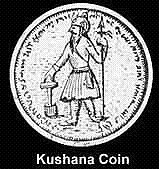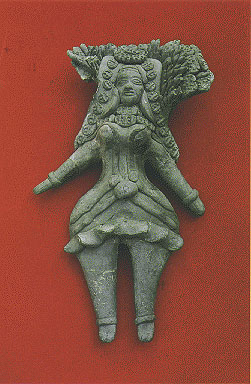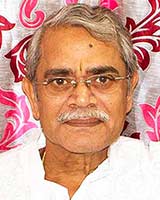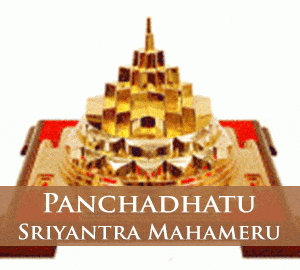Medium of Exchange
Foreign commerce brought a large quantity of specie to India, and we have already referred to Pliny’s complaint about the drainage of Roman coins to this country. 

Industry
The importance of the manufacturing industry in the Maurya period is emphasised by the fact that one committee of the municipal board of Pataliputra was specially entrusted with the supervision of manufactured articles in the metropolis. Greek writers make pointed reference to the manufacture of Maurayan terracotta figurinearms and agricultural implements and the building of ships mainly for purposes of river navigation. Strabo speaks of dresses worked in gold and adorned with precious stones and also flowered robes made of fine muslin worn by the wealthy classes, and umbrellas used by their attendants. Indian muslin was exported in large quantities to the Roman empire in the first century AD. Muslins of the finest sort were then called Gangetic and were produced in the valley of the lower Ganges. The fame of Eastern Bengal and the Gangetic delta for its white and soft dukula is also vouched for by the Kautiliya Arthasastra. The fabric produced in Northern Bengal was black and as smooth as the surface of a gem. Muslins in great quantity were also exported from several market towns of southern India. The North-West was famous for its cotton cloth and silk yarn. The weaving industry gave employment to hundreds of helpless women and special arrangements were made for those who did not stir out of their houses. Weavers and other handicraftsmen were often organised into economic corporations called Srenis. Srenis or guilds were very much in evidence during this period. Records of the Satavahana age refer to guilds of weavers, braziers, oil-millers, bamboo-workers, corn-dealers, and of artisans fabricating hydraulic engines. These guilds often served the purpose of modern banks.
Religion
For a description of the state of religion in the days of the Imperial Mauryas and their successors we have to rely on Greek and Latin authors, inscriptions and coins, the Mahabhashya of Patanjali and the testimony of later writers. The worship of the Vedic gods was still far from obsolescent. Zeus Ombrios, the rain-god, worshipped by the Indians, probably represents the Vedic Indra or Parjanya. Indra and Varuna are invoked as late as the Satavahana period. But side by side with them appear other deities whose popularity dates from the epic period. The river Ganges, for example, is mentioned as an object of worship by classical writers. Quintus Curtius states that an image of Herakles was carried in front of the army of Poros as he advanced against the Macedonian conqueror. The connection of the Indian Herakles with the Surasenas and the city of Mathura suggests his identification with Vasudeva or Sankarshana. Patanjali refers to the exhibition and sale by the Mauryas of images of Siva, Skanda and Visakha. Skanda and Visakha retained their popularity till the Kushana period when they appeared on the coins of Huvishka. Even Asoka, in many respects a great innovator, took pride in calling himself devanampiya, Beloved of the Gods.
Sacrifices are very much in evidence during this age. Of the occasions on which the Maurya king, according to Strabo, went out in times of peace, one was for the performance of sacrifice. Sacrifices were also offered by private persons and the services of “philosophers” were requisitioned for the purpose. The people of India, generally sober, freely indulged in drink when these ceremonies were performed. Asoka tried to put a stop to the killing of living creatures on such occasions. Vaishnava reformers made an attempt to spiritualise sacrifices by giving them a new ethical meaning. But a great Brahmanic revival followed the rise of the houses of Pushyamitra, Simuka-Satavahana and Siva-skandavarman Pallava. Rites like the Asvamedha and Vajapeya came to be celebrated by princes on a grand scale.
From the beginning of the period Brahmanism had to reckon with the heterodox creeds of the Ajivikas, Jainas and Buddhists which obtained a firm hold on certain sections of the people, especially in Oudh, Bihar and Orissa. Tradition says that Chandragupta and Samprati of the Maurya dynasty were Jainas. The epithet Vrishala, applied to the first Maurya by a Brahmanical playwright, makes it likely that in his later days he swerved from strict orthodoxy. An undoubted Jaina king of this period was Kharavela, who, strange to say, engaged in sanguinary conflicts with his neighbours in spite of the quietest teachings of the Arhats and Siddhas, saints and perfect beings, whom he invokes at the beginning of his inscription. Jainism enjoyed special pre-eminence at Mathura during the early centuries of the Christian era, along with the cult of the Nagas or Serpent deities like Dadhikarna. The rival sect of the Ajivikas enjoyed, like many other denominations, the bounty of the emperors Asoka and Dasaratha who granted cave dwellings for these sectaries. If tradition is to be believed the Ajivikas were also favoured by Bindusara.
Buddhism, as is well known, secured the imperial patronage of Asoka and became, mainly through his efforts, a world religion. It received marked favour from Menander and made a convert of the great Kanishka. But the Buddhism of Kanishka differed much from the simple ethical creed of the great Maurya. The human teacher of the four noble truths and the noble eight-fold path now became not merely a deva (deity) but devatideva (the god of gods). like the Blessed Lord of the Bhagavatas or Vaishnavas he is repeatedly born in the world of the living to remove the affliction of creatures and reveal to them the true law. Images of the teacher now appear in Buddhist sculpture and receive the devout worship of the faithful, like the icons of Brahmanic deities. Side by side with the Buddha appear the dhyani Buddhas and Bodhisatvas. The newer Buddhism was known as the Mahayana or the Great Vehicle to distinguish it from the older creed which came to be styled Hinayana. The formulation of its basic ideas is associated with the name of Nagarjuna, a philosopher of the Satavahana period. In the early centuries of the Christian era Buddhism spread to China and several other parts of central, eastern and southern Asia. The Nagarjuna inscriptions make mention of the fraternities of monks who converted Kashmir, Gandhara, China, Chilata, Tosali, Aparanta, Vanga, Vanavasi, Yavana, Damila, Palura and the island of Ceylon. The introduction of Buddhism into China is traditionally attributed to a sage named Kasyapa Matanga. There is, however, evidence to show that, Buddhist scriptures were communicated to the Chinese by a Yue-chi Chief as early as 2 BC.
Another Indian faith which showed great missionary activity was Bhagavatism or Vaishnavism, which already in the second century BC spread amongst the Greeks of the Indian borderland. Heliodoros, the ambassador of Antialkidas, king of Taxila, set up a Garuda column at Besnagar in honour of Vasudeva, the God of gods. Several contemporary epigraphs bear testimony to the prevalence, especially in Central India and the Deccan, of the cult of Vasudeva and Sankarshana, that is Krishna and his brother. The rival cult of Siva enjoyed the patronage of Kadphises II and Vasudeva Kushan. A foreign religion, Christianity, claims to have established some connection with the Indian borderland in the days of Gondophernes. The worship of Babylonian, Iranian and other non-Indian deities like Nanaia, Mithra or Mihira (Sun), Mao (Moon), and Pharro (Fire) in the Kushan empire is proved by numismatic evidence. The cult of Mihira attained much popularity, thanks to the endeavours of the Magian priesthood.











